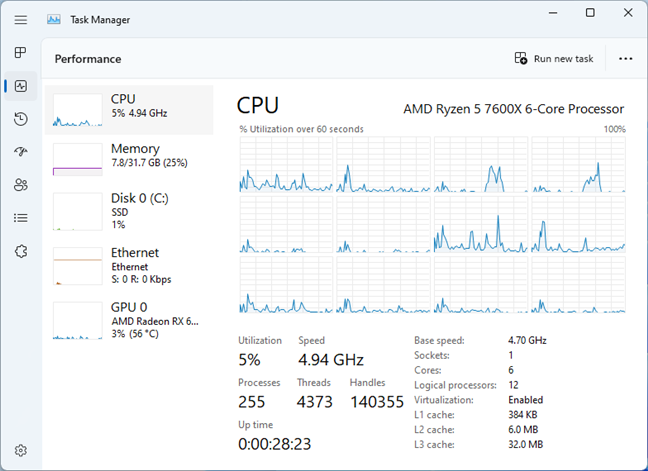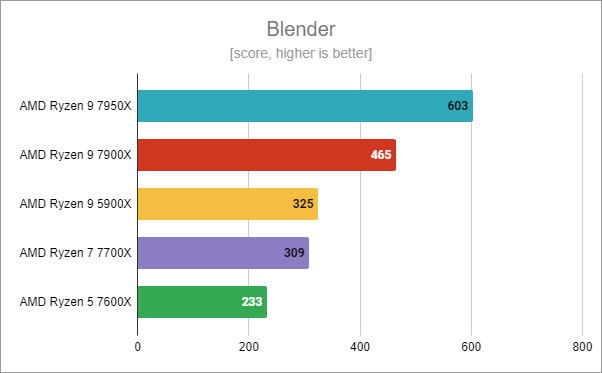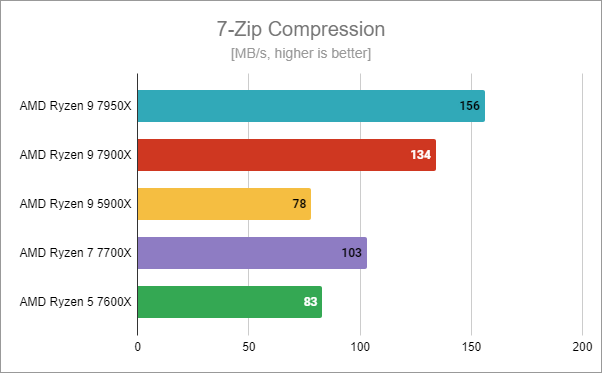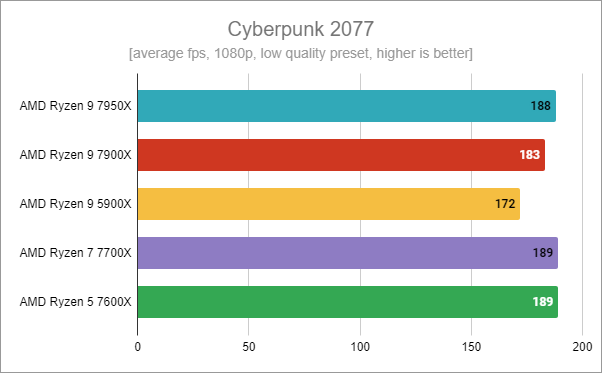
This fall, AMD launched a new generation of desktop processors based on their latest Zen 4 architecture. Right now, there are four CPUs in the lineup, the Ryzen 9 7950X and 7900X, the Ryzen 7 7700X, and the Ryzen 5 7600X. The latter is the most affordable but still offers six cores, twelve execution threads, and a boost clock that can reach an impressive speed of 5.3 GHz. In this review, I’d like to tell you what it can do in real life, in everyday tasks, and especially in gaming. Here’s what you should know about the AMD Ryzen 5 7600X:
AMD Ryzen 5 7600X: Who is it good for?
The AMD Ryzen 5 7600X is the best choice you could make if:
- You want to move on to the new AM5 platform while keeping your costs in check
- You’re looking for an outstanding desktop processor that shines in gaming
- You own a PC that’s two or three generations old and want to make the jump to DDR5, PCIe Gen 5.0, Wi-Fi 6E, and other goodies
Pros and cons
Here are the key positive aspects of the AMD Ryzen 5 7600X:
- It offers top-notch performance in games
- It’s great for daily use, office apps, and browsing the web
- It’s compatible with PCI Express 5 and works with fast DDR5 memory
- The performance-per-watt ratio is excellent
- It has the lowest price from the AMD Ryzen 7000 family
There are a few drawbacks too:
- AM5 motherboards have steep prices
- Ryzen 5 7600X requires DDR5, which is also expensive

Verdict
The AMD Ryzen 5 7600X is the obvious choice for any gamer with an older PC, who wants to jump on the AM5 platform and aims to keep their budget in check. That’s important, considering that the full cost of getting a new motherboard and DDR5 RAM is quite substantial, even if you go with “entry-level” choices. For 299 USD/EUR, the Ryzen 5 7600X offers gaming performance that’s almost identical to its higher-end brothers from the Zen 4 family and represents a serious improvement over any of the previous-generation AMD Ryzen 5000 processors. If you don’t do video rendering or work with CAD software, but you’re interested in gaming performance, then the AMD Ryzen 5 7600X is the desktop processor you should get.
Unboxing the AMD Ryzen 5 7600X
The AMD Ryzen 5 7600X processor comes in a compact rectangular box. It’s made of matte light gray cardboard, features some orange accents, and lets you see the CPU inside through a small cutout on the front.

The packaging for AMD Ryzen 5 7600X
Inside the box, you find the AMD Ryzen 5 7600X processor, a small Ryzen 5 7000 series sticker, and a leaflet containing warranty and installation information.

What's inside the box of the AMD Ryzen 5 7600X
I’ve enjoyed unboxing the AMD Ryzen 5 7600X, although the content of the box is practical and simple.
Hardware specifications
The AMD Ryzen 5 7600X is the smaller brother of the Ryzen 7000 family of desktop CPUs. Just like the other processors in the 7000 series, it’s built on AMD’s new Zen 4 architecture. Using a 5-nanometer manufacturing process, the company assures us that this new series of processors brings an average of 13% IPC (instructions per clock) improvement, up to 29% single-core better performance, and up to 27% better performance-per-watt compared to the previous Zen 3 generation.

The AMD Ryzen 5 7600X desktop processor
At a recommended price of 299 USD/EUR, the AMD Ryzen 5 7600X comes with six physical cores and twelve threads. While all the cores run at a base clock of 4.7 GHz, a single core on the processor can boost up to 5.3 GHz! In addition, the processor includes 6 MB of L2 cache and 32 MB of L3 cache memory. The amount of L3 cache is the same as what we got on the now old generation AMD Ryzen 5 5600X, but the L2 cache has doubled from 3 to 6 MB.

AMD Ryzen 5 7600X CPU has 6 cores and 12 threads
The default TDP (Thermal Design Power) value, which gives us an idea of how much power the processor requires in standard situations, is quite low. At 105 Watts, the AMD Ryzen 5 5600X should be quite friendly with those who worry about expensive energy bills. As we’ll see later in the benchmarks section, the CPU can draw significantly more power than the default TDP, but just for short periods of time and only in extremely demanding scenarios. And, if you put everything in balance, the performance per watt you get is excellent.

AMD Ryzen 5 7600X runs at 4.7 GHz and boosts to 5.3 GHz
The AMD Ryzen 5 7600X works with DDR5 memory only, and the default memory speed is 5200 MT/s (mega transfers per second). However, 6000 MT/s DDR5 is what you should look at in order to achieve the best performance per price value. Also, it would be preferable if you could get RAM that’s compatible with the new AMD EXPO (Extended Profiles for Overclocking). Like the Intel XMP standard, the AMD EXPO offers the easiest and fastest way for you to apply the overclock settings for the RAM modules in your AMD-powered computer.

AMD Ryzen 5 7600X has a pinless design
Before moving on to the benchmarks section of the review, you should also know that if you’re looking to buy an AMD Ryzen 5 7600X, you’ll also need a new motherboard. That’s because this processor uses the new AM5 socket, which is available only on the latest AMD 600-series chipsets. Check your favorite retailer for a motherboard based on an X670E, X670, B650E, or B650 chipset. Note that while the AMD Ryzen 5 7600X supports PCI Express 5.0, the availability of PCIe 5.0/4.0 graphics and NVMe storage lanes differ according to the motherboard chipset and the motherboard’s manufacturer.
If you want to check all the technical specs of this desktop processor, visit its official webpage: AMD Ryzen 5 7600X.
The AMD Ryzen 5 7600X might be the most affordable Zen 4 processor, but it still packs an impressive amount of performance. With its six cores, a generous amount of cache memory, and high boost frequency, it has all the specs required to become a favorite for gamers.
Performance in benchmarks and games
I tested the AMD Ryzen 5 7600X processor on a PC with the following hardware and software:
- Motherboard: ASUS TUF Gaming B650-Plus WiFi
- CPU cooler: Cooler Master MasterLiquid ML360R RGB
- Memory: Kingston Fury Beast RGB DDR5-6000 32GB
- Graphics Card: AMD Radeon RX 6800 (16GB)
- Storage: Kingston KC3000 NVMe PCIe 4.0 SSD (2TB)
- Monitor: ASUS ROG Strix XG32VQ Curved Gaming Monitor (1440p, 144Hz)
- Power Supply Unit: ASUS ROG Thor 850W Platinum
- Operating System: Windows 11 Pro version 22H2

AMD Ryzen 5 7600X mounted on an B650 motherboard
To see what to expect in real life from the AMD Ryzen 5 7600X, I compared its results in benchmarks and games with those I got using an:
- AMD Ryzen 9 7950X (Zen 4, 16 cores, 32 threads, 4.5 GHz, up to 5.7 GHz)
- AMD Ryzen 9 7900X (Zen 4, 12 cores, 24 threads, 4.7 GHz, up to 5.6 GHz)
- AMD Ryzen 9 5900X (Zen 3, 12 cores, 24 threads, 3.7 GHz, up to 4.8 GHz)
- AMD Ryzen 7 7700X (Zen 4, 8 cores, 16 threads, 4.5 GHz, up to 5.4 GHz)
NOTE: While the test computer I used for the AMD Ryzen 9 7900X was the same as for the AMD Ryzen 5 7600X, the hardware and software used with the other processors were slightly different. For the Ryzen 9 7950X and Ryzen 7 7700X, I used an ASUS ROG Crosshair X670E Hero motherboard, a G.Skill Trident Z5 Neo DDR5-6000 32GB memory, and Windows 11 21H2. For the AMD Ryzen 9 5900X, I used an ASUS ROG Crosshair VIII Hero (Wi-Fi) motherboard, a HyperX Predator DDR4-3200 RGB 16GB memory, and Windows 11 22H2.
I began by benchmarking the AMD Ryzen 5 7600X with CPU-Z’s Single-thread test. As you can see in the chart below, the processor got a high score of 757 points, proving to be almost as fast as its older brothers in the Zen 4 family. Moreover, compared to the upper-class but previous-gen Ryzen 9 5900X, the performance increase is significant: over 14%.

AMD Ryzen 5 7600X: CPU-Z Single Thread benchmark results
In the CPU-Z Multi-Thread test, the Ryzen 5 7600X couldn’t compare to the other CPUs in my list. That’s normal, as they all have more cores and threads, and this is a multi-thread test. However, the score of the Ryzen 5 7600X was still a good one: 6101 points. Looking at the numbers, you can see, for instance, that the Ryzen 9 7900X has a score that’s two times better, but it also has double the number of cores. 🙂

AMD Ryzen 5 7600X: CPU-Z Multi Thread benchmark results
In the first rendering benchmark I ran, Cinebench R23, the AMD Ryzen 5 7600X achieved a score of 14887 points. Again, the result is directly proportional to the number of cores/threads. Still, we’re looking at a good result for a six-core CPU.

AMD Ryzen 5 7600X: Cinebench R23 benchmark results
In Blender, the AMD Ryzen 7600X scored 233 points, which is 50% of what the Ryzen 9 7900X managed. Yet again, it also has exactly half the number of cores/threads of the Ryzen 9 7900X.

AMD Ryzen 5 7600X: Blender benchmark results
In the benchmark tool from 7-Zip, one of the most popular file compression software, the AMD Ryzen 5 7600X reached a compression rate of 83 MB/s. That’s an outstanding result: while it’s not as fast as the other Zen 4 processors, the Ryzen 5 7600X, with its 6 cores and 12 threads, is faster than the Zen 3 Ryzen 9 5900X, which has 12 cores and 24 threads!

AMD Ryzen 5 7600X benchmark results: 7-Zip Compression
The decompression speed measured by 7-Zip wasn’t breathtaking, but it wasn’t substandard either. With 1193 MB/s, the Ryzen 5 7600X is still a fast processor.

AMD Ryzen 5 7600X benchmark results: 7-Zip Decompression
Moving on to more real-life daily tasks, I ran the JetStream 2 benchmark in Google Chrome to see how fast the AMD Ryzen 5 7600X processor is when navigating the internet. Here, the number of cores/threads has a much smaller impact on the performance, and the Ryzen 5 7600X managed to keep in line with all the other Zen 4 processors, getting an exceptional score of 319 points. That’s about 22% better than the high-end AMD Ryzen 9 5900X CPU from the previous Zen 3 generation.

AMD Ryzen 5 7600X: JetStream 2 benchmark results
The following benchmark I chose was PCMark 10. I use it because it offers a fairly clear view of how fast a computer and evidently the processor is in standard activities like browsing the web, participating in video conferences, working with office productivity apps, and creating digital content. The AMD Ryzen 5 7600X managed a stellar score of 9445 points. That’s a performance increase of almost 14% from the previous gen Ryzen 9 5900X. Also, it’s a similar result to the ones I got with the other, more powerful, Zen 4 Ryzen 7000 series processors. In fact, the score I got is slightly better than the one of the Ryzen 7 7700X, but don’t forget that I had different hardware and the previous Windows 11 version (22H1) when I tested that one (which might also explain these results).

AMD Ryzen 5 7600X: PCMark 10 benchmark results
Next came the time for checking what the AMD Ryzen 5 7600X can do in games. First, I ran the synthetic 3DMark CPU Profile benchmark. It measures the gaming performance of processors when using all or just some of their available cores/threads. The best games today can take advantage of multiple cores, so I’m looking mainly at the all-thread scores in this benchmark. The AMD Ryzen 5 7600X managed 7288 points, which is a top-notch result for a six-core processor, although not as high as what I got with the other, more powerful but also more expensive CPUs.

AMD Ryzen 5 7600X benchmark results in 3DMark CPU Profile Max Threads
And now, let’s see some actual game benchmarks. Note that, to make an unbiased evaluation of the AMD Ryzen 5 7600X, I ran all the following games in 1080p resolution using the lowest graphics quality settings available. This should decrease the chance of encountering bottlenecks from the graphics card (AMD Radeon RX 6800) or the other hardware in my test computer.
In Shadow of the Tomb Raider, with the AMD Ryzen 5 7600X, I measured an average framerate of 294. That’s an exceptional result, in line with the AMD Ryzen 7 7700X and Ryzen 9 7900X. While 12.5% lower than what I got with the high-end AMD Ryzen 9 7950X, it’s also better by 20% than the number of frames per second rendered by the Zen 3 AMD Ryzen 9 5900X.

AMD Ryzen 5 7600X - Gaming in Shadow of the Tomb Raider
In Metro Exodus, an exceptionally demanding game, I measured a framerate of 323 fps. That’s similar to the number of frames per second rendered by all the other Ryzen 7000 processors, but it’s a 24% increase from what you get with a previous generation AMD Ryzen 9 5900X.

AMD Ryzen 5 7600X - Gaming in Metro Exodus
In Cyberpunk 2077, all the Zen 4 processors managed framerates of over 180, and, once more, the improvement over the last-generation Zen 3 processors is easily noticeable. Compared to the AMD Ryzen 9 5900X, the Ryzen 5 7600X offers a framerate increase of almost 10%.

AMD Ryzen 5 7600X - Gaming in Cyberpunk 2077
The fourth and last game I checked was Assassin's Creed Valhalla. It requires a particularly high amount of hardware resources to run at maxed visuals, and, as you can see in the chart below, the AMD RX 6800 graphics card seems to have bottlenecked all four Ryzen 7000 processors. All of them, including the Ryzen 5 7600X, rendered 204~205 frames per second on average. Still, I can see a performance improvement compared to Zen 3 processors, as the Ryzen 9 5900X rendered about 7% fewer frames per second.

AMD Ryzen 5 7600X - Gaming in Assassin's Creed Valhalla
To check what the highest temperature reached by the AMD Ryzen 5 7600X is, I ran Prime95 while keeping an eye on Open Hardware Monitor. I discovered that the processor can hit 96 degrees Celsius (~205 Fahrenheit). It’s high, but this is normal according to AMD’s technical specifications for the Ryzen 7000 processors.

Running temperatures for AMD Ryzen 5 7600X
The power efficiency of the AMD Ryzen 5 7600X is excellent. With a measured 130 Watts maximum power draw, I consider this processor to offer an outstanding performance-per-watt ratio. Also, keep in mind that this is not the regular energy consumption of the processor. This is only the maximum draw, which usually happens only for short times in very demanding situations. In regular activities and even in gaming, the electricity required by this CPU is significantly lower.

AMD Ryzen 5 7600X power consumption
The AMD Ryzen 5 7600X is a remarkable desktop processor. Although it “only” has six cores and twelve threads, it practically offers a level of performance in gaming that’s similar if not the same as what you get from its older brothers in the Zen 4 family. The multicore performance is also excellent for any kind of productivity task, and the improvement over the last gen Zen 3 Ryzen processors is impressive.
What’s your opinion about the AMD Ryzen 5 7600X?
The AMD Ryzen 5 7600X feels like it’s one of the best choices for people who want to move on to the AM5 platform and are looking for top-notch performance in gaming at a reasonable price. Thanks for reading this review, and before you go, would you mind letting me know what your thoughts about the Ryzen 5 7600X are? Feel free to use the comments section below to share your perspective.


 07.11.2022
07.11.2022 

